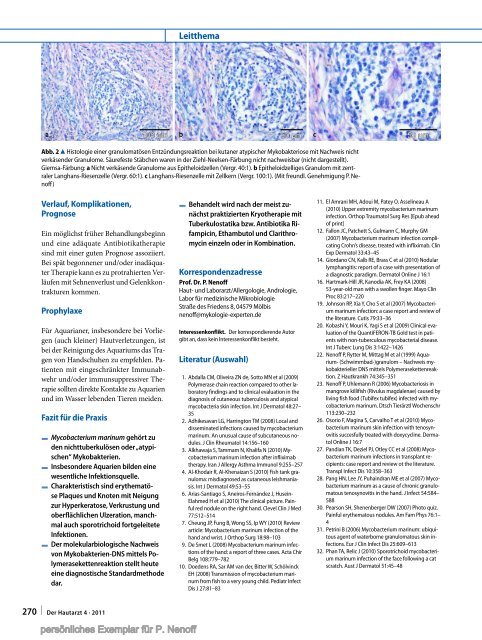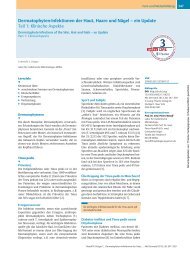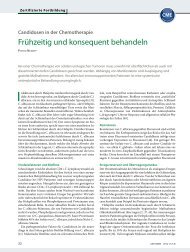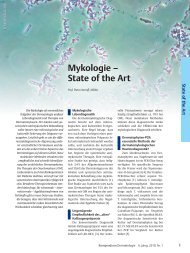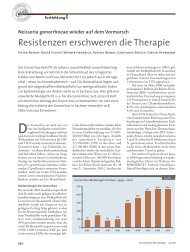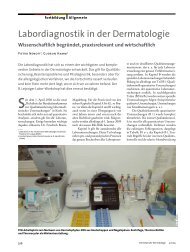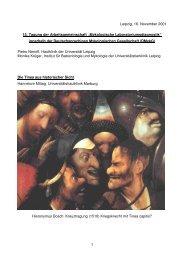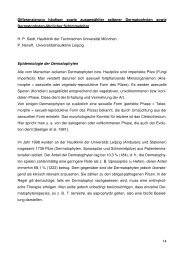Kutane Infektionen durch Mycobacterium marinum Eine Übersicht
Kutane Infektionen durch Mycobacterium marinum Eine Übersicht
Kutane Infektionen durch Mycobacterium marinum Eine Übersicht
Erfolgreiche ePaper selbst erstellen
Machen Sie aus Ihren PDF Publikationen ein blätterbares Flipbook mit unserer einzigartigen Google optimierten e-Paper Software.
Abb. 2 8 Histologie einer granulomatösen Entzündungsreaktion bei kutaner atypischer Mykobakteriose mit Nachweis nicht<br />
verkäsender Granulome. Säurefeste Stäbchen waren in der Ziehl-Neelsen-Färbung nicht nachweisbar (nicht dargestellt).<br />
Giemsa-Färbung: a Nicht verkäsende Granulome aus Epitheloidzellen (Vergr. 40:1). b Epitheloidzelliges Granulom mit zentraler<br />
Langhans-Riesenzelle (Vergr. 60:1). c Langhans-Riesenzelle mit Zellkern (Vergr. 100:1). (Mit freundl. Genehmigung P. Nenoff)<br />
Verlauf, Komplikationen,<br />
Prognose<br />
Ein möglichst früher Behandlungsbeginn<br />
und eine adäquate Antibiotikatherapie<br />
sind mit einer guten Prognose assoziiert.<br />
Bei spät begonnener und/oder inadäquater<br />
Therapie kann es zu protrahierten Verläufen<br />
mit Sehnenverlust und Gelenkkontrakturen<br />
kommen.<br />
Prophylaxe<br />
Für Aquarianer, insbesondere bei Vorliegen<br />
(auch kleiner) Hautverletzungen, ist<br />
bei der Reinigung des Aquariums das Tragen<br />
von Handschuhen zu empfehlen. Patienten<br />
mit eingeschränkter Immunabwehr<br />
und/oder immunsuppressiver Therapie<br />
sollten direkte Kontakte zu Aquarien<br />
und im Wasser lebenden Tieren meiden.<br />
Fazit für die Praxis<br />
F <strong>Mycobacterium</strong> <strong>marinum</strong> gehört zu<br />
den nichttuberkulösen oder „atypischen“<br />
Mykobakterien.<br />
F Insbesondere Aquarien bilden eine<br />
wesentliche Infektionsquelle.<br />
F Charakteristisch sind erythematöse<br />
Plaques und Knoten mit Neigung<br />
zur Hyperkeratose, Verkrustung und<br />
oberflächlichen Ulzeration, manchmal<br />
auch sporotrichoid fortgeleitete<br />
<strong>Infektionen</strong>.<br />
F Der molekularbiologische Nachweis<br />
von Mykobakterien-DNS mittels Polymerasekettenreaktion<br />
stellt heute<br />
eine diagnostische Standardmethode<br />
dar.<br />
270 | Der Hautarzt 4 · 2011<br />
Leitthema<br />
F Behandelt wird nach der meist zunächst<br />
praktizierten Kryotherapie mit<br />
Tuberkulostatika bzw. Antibiotika Rifampicin,<br />
Ethambutol und Clarithromycin<br />
einzeln oder in Kombination.<br />
Korrespondenzadresse<br />
Prof. Dr. P. Nenoff<br />
Haut- und Laborarzt/Allergologie, Andrologie,<br />
Labor für medizinische Mikrobiologie<br />
Straße des Friedens 8, 04579 Mölbis<br />
nenoff@mykologie-experten.de<br />
Interessenkonflikt. Der korrespondierende Autor<br />
gibt an, dass kein Interessenkonflikt besteht.<br />
Literatur (Auswahl)<br />
1. Abdalla CM, Oliveira ZN de, Sotto MN et al (2009)<br />
Polymerase chain reaction compared to other laboratory<br />
findings and to clinical evaluation in the<br />
diagnosis of cutaneous tuberculosis and atypical<br />
mycobacteria skin infection. Int J Dermatol 48:27–<br />
35<br />
2. Adhikesavan LG, Harrington TM (2008) Local and<br />
disseminated infections caused by mycobacterium<br />
<strong>marinum</strong>. An unusual cause of subcutaneous nodules.<br />
J Clin Rheumatol 14:156–160<br />
3. Alkhawaja S, Tammam N, Khalifa N (2010) <strong>Mycobacterium</strong><br />
<strong>marinum</strong> infection after infliximab<br />
therapy. Iran J Allergy Asthma Immunol 9:255–257<br />
4. Al-Khodair R, Al-Khenaizan S (2010) Fish tank granuloma:<br />
misdiagnosed as cutaneous leishmaniasis.<br />
Int J Dermatol 49:53–55<br />
6. Arias-Santiago S, Aneiros-Fernández J, Husein-<br />
Elahmed H et al (2010) The clinical picture. Painful<br />
red nodule on the right hand. Clevel Clin J Med<br />
77:512–514<br />
7. Cheung JP, Fung B, Wong SS, Ip WY (2010) Review<br />
article: <strong>Mycobacterium</strong> <strong>marinum</strong> infection of the<br />
hand and wrist. J Orthop Surg 18:98–103<br />
9. De Smet L (2008) <strong>Mycobacterium</strong> <strong>marinum</strong> infections<br />
of the hand: a report of three cases. Acta Chir<br />
Belg 108:779–782<br />
10. Doedens RA, Sar AM van der, Bitter W, Schölvinck<br />
EH (2008) Transmission of mycobacterium <strong>marinum</strong><br />
from fish to a very young child. Pediatr Infect<br />
Dis J 27:81–83<br />
11. El Amrani MH, Adoui M, Patey O, Asselineau A<br />
(2010) Upper extremity mycobacterium <strong>marinum</strong><br />
infection. Orthop Traumatol Surg Res [Epub ahead<br />
of print]<br />
12. Fallon JC, Patchett S, Gulmann C, Murphy GM<br />
(2007) <strong>Mycobacterium</strong> <strong>marinum</strong> infection complicating<br />
Crohn’s disease, treated with infliximab. Clin<br />
Exp Dermatol 33:43–45<br />
14. Giordano CN, Kalb RE, Brass C et al (2010) Nodular<br />
lymphangitis: report of a case with presentation of<br />
a diagnostic paradigm. Dermatol Online J 16:1<br />
16. Hartmark-Hill JR, Kanodia AK, Frey KA (2008)<br />
53-year-old man with a swollen finger. Mayo Clin<br />
Proc 83:217–220<br />
19. Johnson RP, Xia Y, Cho S et al (2007) <strong>Mycobacterium</strong><br />
<strong>marinum</strong> infection: a case report and review of<br />
the literature. Cutis 79:33–36<br />
20. Kobashi Y, Mouri K, Yagi S et al (2009) Clinical evaluation<br />
of the QuantiFERON-TB Gold test in patients<br />
with non-tuberculous mycobacterial disease.<br />
Int J Tuberc Lung Dis 3:1422–1426<br />
22. Nenoff P, Rytter M, Mittag M et al (1999) Aquarium-<br />
(Schwimmbad-)granulom – Nachweis mykobakterieller<br />
DNS mittels Polymerasekettenreaktion.<br />
Z Hautkrankh 74:345–351<br />
23. Nenoff P, Uhlemann R (2006) Mycobacteriosis in<br />
mangrove killifish (Rivulus magdalenae) caused by<br />
living fish food (Tubifex tubifex) infected with mycobacterium<br />
<strong>marinum</strong>. Dtsch Tierärztl Wochenschr<br />
113:230–232<br />
26. Osorio F, Magina S, Carvalho T et al (2010) <strong>Mycobacterium</strong><br />
<strong>marinum</strong> skin infection with tenosynovitis<br />
succesfully treated with doxycycline. Dermatol<br />
Online J 16:7<br />
27. Pandian TK, Deziel PJ, Otley CC et al (2008) <strong>Mycobacterium</strong><br />
<strong>marinum</strong> infections in transplant recipients:<br />
case report and review ot the literature.<br />
Transpl Infect Dis 10:358–363<br />
28. Pang HN, Lee JY, Puhaindran ME et al (2007) <strong>Mycobacterium</strong><br />
<strong>marinum</strong> as a cause of chronic granulomatous<br />
tenosynovitis in the hand. J Infect 54:584–<br />
588<br />
30. Pearson SH, Shenenberger DW (2007) Photo quiz.<br />
Painful erythematous nodules. Am Fam Phys 76:1–<br />
4<br />
31. Petrini B (2006) <strong>Mycobacterium</strong> <strong>marinum</strong>: ubiquitous<br />
agent of waterborne granulomatous skin infections.<br />
Eur J Clin Infect Dis 25:609–613<br />
32. Phan TA, Relic J (2010) Sporotrichoid mycobacterium<br />
<strong>marinum</strong> infection of the face following a cat<br />
scratch. Aust J Dermatol 51:45–48


